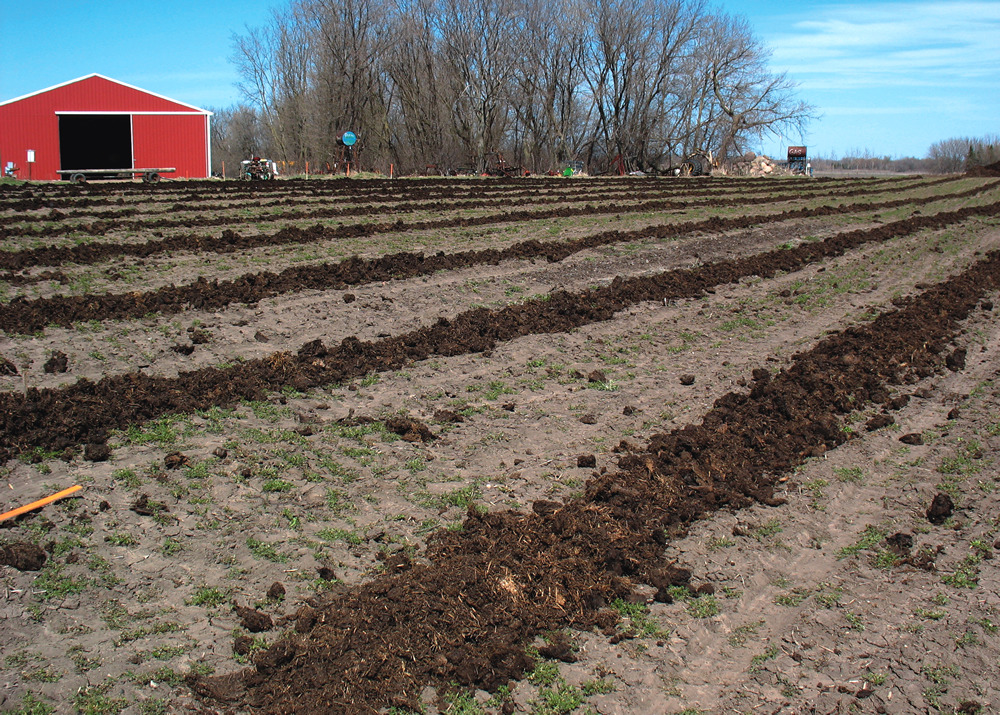Water retention, disease suppression and improved soil health are just a few of the perks of amending agricultural soils with recycled organics.
Dan Sullivan
BioCycle August 2012, Vol. 53, No. 8, p. 33
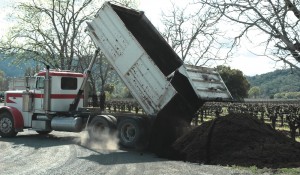
Contracted haulers bring compost from Recology’s Jepson Prairie Organics in Vacaville, California, to Chateau Montelena in the Napa Valley.
Spent mushroom substrate that is steam sterilized before being delivered to his farm is composted by Stark for three to four months. The compost is turned with a bucket loader on occasion (particularly if it gets wet). The end product is applied to his fields at about 35 to 50 cubic yards (cy)/acre. Where Stark’s hay kept growing through a summer dry spell, he says, his neighbors’ hay stopped growing altogether — a fact he attributes to the water-holding capacity of his compost-amended soils. “And it keeps the pH closer to neutral, so I don’t really have to add lime,” he adds. “All the micronutrients are there. There was definitely a boron deficiency before I began spreading the composted mushroom substrate, but now the boron levels are up.”
Stark has seen disease suppression benefits from compost utilization: “Even when I do get disease if it rains a lot, the plants seem to do okay — except for when late blight hits. When I see disease, it generally doesn’t bother me as much because I figure the plants are going to hold on, and they do.” He uses a rear-delivery manure spreader (New Idea). “It is more convenient to spread the compost during the window of opportunity before plowing,” “It’s better to plow and spread if the ground is not too wet, in which case I disc it in. If I spread it and then plow it under, it is better to use a chisel plow or cultivator afterwards, since the long tines do a good job of bringing up some of the plowed-under compost and mixing it with the soil.”
At the Chateau Montelena vineyard in Calistoga, California, compost made from yard trimmings and food waste is spread in the rows between the grape vines right after harvest at a rate of up to 3 tons/acre. The vineyard also uses a rear-delivery manure spreader (S&A Manufacturing) to apply the compost, which is then worked into the soil with a tractor-mounted rotary spader. Cover crops are planted to suppress weeds and stimulate the soil microbiology. The compost is manufactured by Recology, which services source separated organics recycling programs in the Bay Area, including San Francisco. Recology produces about 150,000 cy of compost annually and supplies more than 200 Napa Valley wineries.
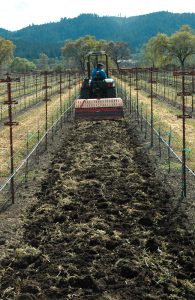
After being spread between vine rows, the compost is worked into the soil with a tractor-mounted rotovator.
Improving The Soils
Jeff Moyer is farm director at the 333-acre Rodale Institute, an organic education and research farm in Kutztown, Pennsylvania. Compost is generally applied in rotation at a rate of approximately 10 tons/acre every three to five years. “Because of the nature of our field activities, including no-till planting into rolled/crimped cover crops, we apply compost to small grain fields such as oats and wheat once the crop is harvested in August,” says Moyer. “We have time since fall harvest and planting season aren’t upon us yet, and since we are feeding the soil, not the crop, it doesn’t matter when we apply the material.”
With vegetable production, more compost may be applied at several different points in the rotation, depending on the crops grown. “All the crops in the rotation benefit,” explains Moyer. “When compost is used in a crop production system that includes cover crops as the primary source of nitrogen, the soil health improved, we irrigated less and the soil organic matter content increases.” Compost feedstocks include municipal leaves, food waste and poultry litter. The Institute owns three paddle-type manure spreaders — two larger models (International) and a smaller unit (Millcreek Manufacturing Co.).
Fourth generation farmer Martin Diffley has farmed organically south of the Twin Cities in Minnesota since 1973. A veteran of the organic farming movement and now semi retired, one of Diffley’s specialties over the years has been customizing farming equipment specifically for organic production. “Martin has about three different designs including one that he custom built to funnel compost out the back in a row,” explains his wife and farming partner, Atina Diffley. “We used it to focus the fertility directly under the plant for tomatoes, melons and cucumbers.”
When applying the compost, the Diffleys would lay a line 18 inches wide by 2 to 3 inches deep of dairy cow compost blended with turkey compost, and, when needed, rock phosphate and calcium. This was incorporated shallowly (but not pulverized) over the compost row. It was then covered with green thermal plastic, which served to heat up the soil, bringing heat-loving crops in 2 to 3 weeks earlier and increasing yield. The combination of compost and plastic mulch provided disease suppression, pest control and overall good health.
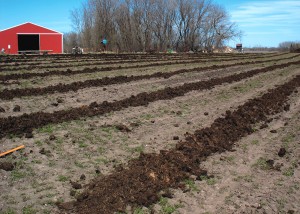
Compost is spread heavily to focus fertility for row crops on Gardens of Eagan farm in Eureka Township, Minnesota.
A side flail “slinger” spreader (Gehl) was used to spread 6 to 8 tons/acre of a dairy/ turkey blend on land that was depleted. The spreader can handle material with high amounts of straw or other carbon source. “This system was developed for soils with less than 1 percent organic matter, and it could take quite bit of compost without jeopardizing the nutrient load,” Martin Diffley explains. When land was in transition or the soil was depleted, compost sometimes would be applied at 8 to12 tons/acre, followed with a series of soil-building crops — hairy vetch, rye and Sorghum Sudan grass — to establish stable nutrient cycling. “Compost and clean cultural practices were our most effective disease management tools,” he says. “During extended droughts, the moisture retention benefits of compost use were obvious. The fields hold moisture better than our conventional [farming] neighbors, and the soil stays friable and pests are generally less interested in the crops. The benefits last for years after application.”
Supplementing Citrus
Robert C. Adair, Jr., executive director of the Florida Research Center for Agricultural Sustainability in Vero Beach, paints a challenging picture for the citrus industry in the Sunshine State, particularly for the Indian River Citrus region of the east central coast where the center is located. Three impact or killing freezes in 1983, 1985 and 1989, a series of back-to-back hurricanes that repeatedly toppled the shallow-rooted trees in 2004, development pressure and a host of pests and diseases have all taken their toll on Florida’s $9 billion industry.
To give the citrus trees a fighting chance, Adair and his colleagues have developed “New Best Management Practices (BMPs) for Coastal Citrus.” The BMPs address nonpoint source pollution, particularly nitrogen and phosphorus runoff that causes eutrophication of the state’s estuaries. Two main strategies are foliar feeding and mulching with compost to provide both a sink for, and slow release of, nutrients. The method was developed using chipped land clearing debris that contained cabbage palms and in some cases, old orange trees. The chips were piled in windrows and turned two to three times over a 6-month period.
“Since no green matter or nitrogen was added, it composted very slowly,” Adiar says. “When we applied it to our trees, it is mostly mulch that is partially composted. The breakdown to humus makes for a better matrix of mulch. It produces a really good product that is high in carbon, has almost zero nitrogen and breaks down very slowly from tan to a darker color.” The center lost that source of wood chips when an ethanol plant opened that utilizes the ground chips. They still receive some chipped material and utilize it on the trees.
The success of the project hinged on procurement of a side-delivery compost spreader with the ability to maintain a uniform spread pattern of organic matter to citrus trees, the durability to handle both rough terrain and foreign objects (from the chips), enough capacity for at least 2 acres of application, a design that eliminated material bridging and packing, a reliable means to adjust the application rate and spread width, fast efficient and simple operation, “and most importantly, affordability.” After considering several models, it selected a Kuhn Knight model 8014 ProTwin Slinger Spreader with an application rate of about 2.4 tons/acre.
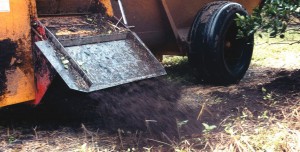
A Kuhn Knight Slinger Spreader applies composted mulch on the root system in a citrus grove on Florida’s east central coast. The application is part of an experiment by the Florida Research Center for Agricultural Sustainability developing best management practices for the state’s citrus industry. (Photo courtesdy of Florida Research Center for Agricultural Sustainability, Inc.)
Added organic matter (1.6 percent is considered high in Florida’s sandy soils) in the form of mature compost seems to help with greening disease, which also makes the trees susceptible to Phytophthora. Adair attributes these results to the fact that compost raises the organic matter in the rhizosphere (root zone), improving the soil texture and feeding the beneficial microorganisms — allowing them to thrive. “Together, this enhances root growth and the new roots outgrow whatever harm the Phytophthora causes,” says Adair.
In another experiment at Merritt Island, Adair incorporated a compost application method developed by colleague Mike Ziegler called the “sandwich application.” This method uses two layers. First a layer of composted broiler litter mixed with sawdust is applied; this is covered with a layer of the partially composted mulch. “The Kuhn spreader put a beautiful 3-foot band of compost at the tree’s drip edge where the roots are,” he says. “The mulch on top acted as a sink and trapped the ammoniacal gas [potentially volatile nitrogen]. The trees really jumped. These are trees that had been abused, where contract growers picked the fruit and put nothing back into the system. The compost application really worked to bring them back.” For more information, visit the center’s website at www.flaresearch.com.


